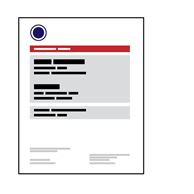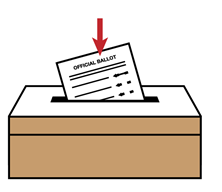Learn about how elections work in Minnesota
Nominating a candidate
Choosing a President
Recalling an elected official
Secure and fair elections
About the ballot
Voting process
Checking votes
Who's in charge?
Election security measures
Before Election Day
In the months and years before an election, officials take numerous steps to prepare for the election. Part of this work includes acquiring, maintaining, and testing elections equipment. These steps are detailed on our Voting Equipment webpage.
Before anyone can vote in Minnesota, they must be registered using a paper or online form submitted to a state or local elections office. Minnesota’s Statewide Voter Registration System is the database, established by state law and administered by the Secretary of State's Office, that lists registered voters. It is maintained through a continuous and rigorous data-matching process done by each of the 87 counties in partnership with a wide array of offices and agencies at the county, state, and federal levels.
Expand the section below to learn more about how voter registration in Minnesota ensures only eligible voters cast ballots.
Read More
With every new or updated voter registration, four steps are followed.
First, every voter who fills out a voter registration application swears under oath that they are eligible to vote. A voter's signature on this application acknowledges that it is a felony to falsify information on their registration.

Second, Minnesota uses centralized database, the Statewide Voter Registration System, to ensure all state and local election officials have access to the latest data at all times. When entering voter registration applications, county auditors first look to see if the person already is registered. If so, then they update that person’s registration; if not, then they create a registration for the person in the system.
Third, voter registration information is verified against Driver and Vehicle Services (DVS), Social Security Administration (SSA), Department of Health, and court records. When voters register to vote or update their registration, they are required to provide a Minnesota driver’s license or state ID number or the last four digits of their Social Security Number, if they have one. This data is verified against the Driver and Vehicle Services or Social Security Administration database. If it cannot be verified, the voter’s record is flagged. For online registrants, data is verified with Driver and Vehicle Services or the Social Security Administration before data is sent to the county for processing.
Fourth, voter addresses are verified. After voter registrations have been entered, each voter is sent a non-forwardable postcard, called a Postal Verification Card, to verify that they live at the address provided. If the postcard is returned as non-deliverable, the voter’s record is challenged, requiring the voter to answer questions under oath about where they live before being allowed to vote.
The Statewide Voter Registration System is updated daily using the following points of data to check existing registrations:
- Inactive voters: Each year, voters who have not voted or updated their registration in four years are removed.
- Deaths: Deceased voters are removed upon notification from the Minnesota Department of Health or Social Security Administration.
- Felons: The records of those who have convicted of felonies and are currently incarcerated are marked as challenged based upon notice from the Court System or Department of Corrections. If someone tries to vote with a challenge on their recorded, they are required to answer questions under oath before being allowed to vote. If an individual attempts to register or to vote when ineligible, their case is referred to a county attorney.
- Revoked Voting Rights: The court system provides notice when a court has specifically revoked the voting rights of an individual under guardianship. The records of any who are registered to vote are challenged, requiring that they answer questions under oath before being allowed to vote.
- Non-citizens: Driver and Vehicle Services provides a list of noncitizens here on temporary visas. The records of any who are registered to vote are challenged, requiring that they answer questions under oath before being allowed to vote, and their case is referred to a county attorney.
- Moves: The records of voters who have moved are updated based upon National Change of Address data provided by the Postal Service, Minnesota Driver and Vehicle Service data, or information shared between state governments.
On Election Day
From election judges in the polling place to the work that counties do after the polls close on Election Night, every step of the process is governed by laws and practices that ensure only eligible voters are voting and that every eligible vote is counted accurately.
Expand the section below to learn more about the election day ballot security measures.
Read More
On Election Day, election judges manage polling places. All sensitive tasks in the polling place, such as assisting a voter or counting the ballots, must be conducted by two election judges of different major political parties.
On Election Day, every voter swears that they are eligible. When voters arrive, election judges ask voters for their name and address, and, if there are any questions, their date of birth. Voters then read the oath at the top of the page and sign the roster next to their name, swearing that they are eligible to vote and acknowledging that giving false information is a felony.
On Election Night, in each polling place, election judges verify that the number of ballots cast matches the number of voters before they leave for the night. They do this by matching the number of ballots to either the number of signatures on the roster or the number of voter receipts. (Each voter who signs the roster is handed a voter receipt, which they must provide to another election judge to receive a ballot.)
On Election Day, absentee voters are prevented from voting more than once. Election officials may not open and count any absentee votes that arrive on Election Day until they have ensured that the individual did not already vote in the polling place. Absentee ballots for state primaries and general elections are required to be tracked in the Statewide Voter Registration System, which will indicate if someone has already voted absentee.
After Election Day
The work of elections security continues after Election Day, as well. Local officials check again to make sure voter information is updated and any discrepancies are resolved.
Expand the section below to learn more about how election officials check their work.
Read More
Voters’ records are marked to indicate that they voted. Counties mark voters’ records in the Statewide Voter Registration System to reflect that they voted in an election (called “voter history”) so that anyone who has not voted in the previous four years can be removed from the list.
The Statewide Voter Registration System checks for anyone who voted more than once. When counties are entering voting history data and election day registrations into the Statewide Voter Registration System, it provides a warning if a voter is already recorded as having voted in the election. Usually, this is a result of a data-entry error; any actual incidents are turned over to the county attorney for further investigation and possible prosecution.
Voters who register to vote on Election Day are entered into the Statewide Voter Registration System and are subject to the same verification procedures mentioned above. If the non-forwardable Postal Verification Card is returned, county auditors must verify the voter’s eligibility. If the auditor cannot do so or if the voter is otherwise identified as ineligible to vote, their case must be forwarded to the county attorney for further investigation and potential prosecution.
Database matches are then run again to ensure only eligible voters cast ballots. The Department of Public Safety provides data on non-citizens and the Department of Corrections provides data on people who were incarcerated for felony convictions during the election. Those datasets are again compared to data in the Statewide Voter Registration System to identify ineligible people who may have voted. If an individual registered or voted when they were not eligible, their record is flagged and their case is turned over to the county attorney for further investigation and potential prosecution.
After each state general election, counties randomly draw a set of precincts where they audit the results from the ballot tabulators. In the audit, votes for certain offices are counted by hand, and that total is compared with the machine-counted results from election night. Read more information on Post Election Reviews.